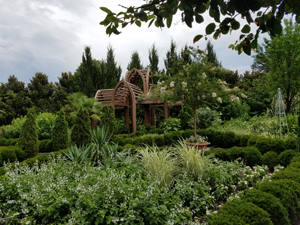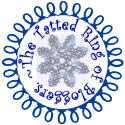I'll put the mignonette rose doily on hold while I work on writing up the pattern. Meanwhile, I'll go back to the yoke I was working on when I got distracted by the doily.
The yoke comes from "Practical Tatting" by Phyllis Sparks. Used copies aren't too hard to find. It has quite a lot of edgings, some doilies, a few nice collars, and this exquisite yoke. Patterns are diagrammed in a style different from the norm, but easy enough to follow once you get used to them. Patterns have more cut and ties than preferred by the modern tatter, but usually not too hard to get around by substituting split rings etc.
Here is the entire yoke as pictured in the book. There are (I think) 86 individual motifs made from 17 patterns. This was to be more than just a project for me, but more of a tatting meditation. Is "centering" the right word? I wanted something old fashioned and elaborate. First, I must make each section correctly, which is sometimes as much about matching the designer's tension and picots as well as following the pattern. Next, all the pieces must fit together. Lastly, I must have the perseverence to complete the project.
Mrs. Sparks writes that you make make the motifs in any order you wish. She began with the large circle near the top and then the bow shaped strip around it. I decided to begin with the large oblongs that go over the shoulders. I thought working a large section would tell me if I could follow her patterns and enjoy them.

So far, so good.
I didn't make a scan with a black background way back then, but since then I found out some of you preferred the dark background, so I tried to photoshop it.
Meanwhile, DS3 and I visited the Sarah Duke Gardens in Durham.
There are several sections, with different themes.
We didn't see it all.
Highly recommended, we will be back.



















.jpg)


































